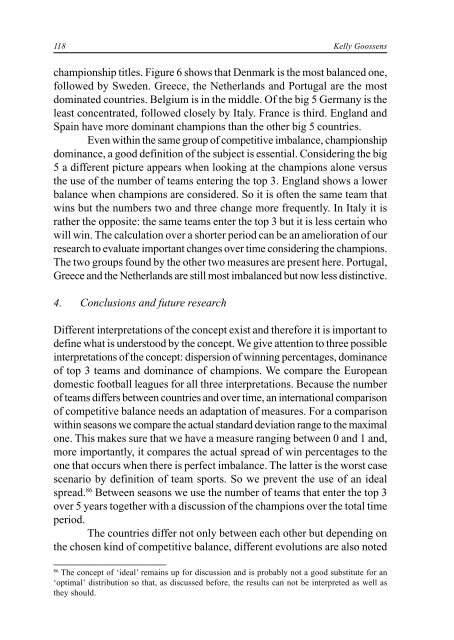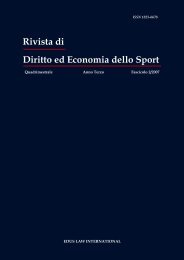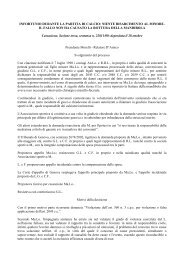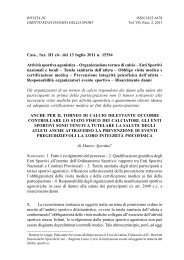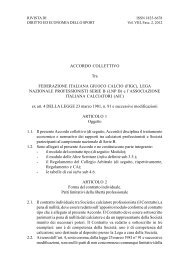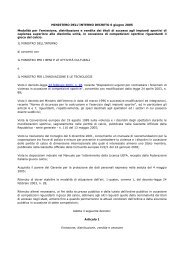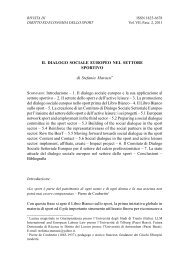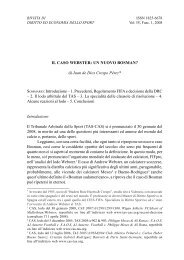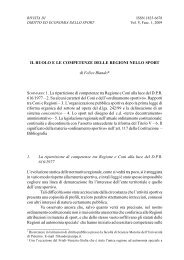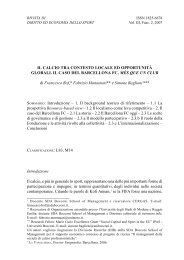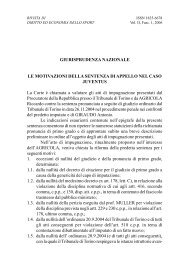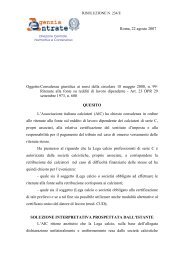Rivista di Diritto ed Economia dello Sport - Rdes.it
Rivista di Diritto ed Economia dello Sport - Rdes.it
Rivista di Diritto ed Economia dello Sport - Rdes.it
You also want an ePaper? Increase the reach of your titles
YUMPU automatically turns print PDFs into web optimized ePapers that Google loves.
118 Kelly Goossenschampionship t<strong>it</strong>les. Figure 6 shows that Denmark is the most balanc<strong>ed</strong> one,follow<strong>ed</strong> by Sw<strong>ed</strong>en. Greece, the Netherlands and Portugal are the mostdominat<strong>ed</strong> countries. Belgium is in the middle. Of the big 5 Germany is theleast concentrat<strong>ed</strong>, follow<strong>ed</strong> closely by Italy. France is third. England andSpain have more dominant champions than the other big 5 countries.Even w<strong>it</strong>hin the same group of compet<strong>it</strong>ive imbalance, championshipdominance, a good defin<strong>it</strong>ion of the subject is essential. Considering the big5 a <strong>di</strong>fferent picture appears when looking at the champions alone versusthe use of the number of teams entering the top 3. England shows a lowerbalance when champions are consider<strong>ed</strong>. So <strong>it</strong> is often the same team thatwins but the numbers two and three change more frequently. In Italy <strong>it</strong> israther the oppos<strong>it</strong>e: the same teams enter the top 3 but <strong>it</strong> is less certain whowill win. The calculation over a shorter period can be an amelioration of ourresearch to evaluate important changes over time considering the champions.The two groups found by the other two measures are present here. Portugal,Greece and the Netherlands are still most imbalanc<strong>ed</strong> but now less <strong>di</strong>stinctive.4. Conclusions and future researchDifferent interpretations of the concept exist and therefore <strong>it</strong> is important todefine what is understood by the concept. We give attention to three possibleinterpretations of the concept: <strong>di</strong>spersion of winning percentages, dominanceof top 3 teams and dominance of champions. We compare the Europeandomestic football leagues for all three interpretations. Because the numberof teams <strong>di</strong>ffers between countries and over time, an international comparisonof compet<strong>it</strong>ive balance ne<strong>ed</strong>s an adaptation of measures. For a comparisonw<strong>it</strong>hin seasons we compare the actual standard deviation range to the maximalone. This makes sure that we have a measure ranging between 0 and 1 and,more importantly, <strong>it</strong> compares the actual spread of win percentages to theone that occurs when there is perfect imbalance. The latter is the worst casescenario by defin<strong>it</strong>ion of team sports. So we prevent the use of an idealspread. 86 Between seasons we use the number of teams that enter the top 3over 5 years together w<strong>it</strong>h a <strong>di</strong>scussion of the champions over the total timeperiod.The countries <strong>di</strong>ffer not only between each other but depen<strong>di</strong>ng onthe chosen kind of compet<strong>it</strong>ive balance, <strong>di</strong>fferent evolutions are also not<strong>ed</strong>____________________86The concept of ‘ideal’ remains up for <strong>di</strong>scussion and is probably not a good subst<strong>it</strong>ute for an‘optimal’ <strong>di</strong>stribution so that, as <strong>di</strong>scuss<strong>ed</strong> before, the results can not be interpret<strong>ed</strong> as well asthey should.


